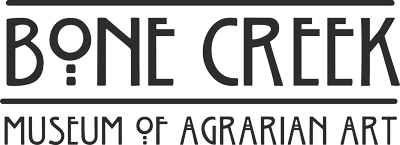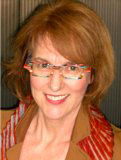Posted by the Omaha World Herald
DAVID CITY, Neb. — Corn is cool, and Lincoln artist Margaret Berry has a hard time figuring out why more of her Cornhusker State brethren don’t quite get that.
As a subject of art, corn has beautiful color, shape and texture, said Berry, who was surrounded by cornfields as she grew up on a farm outside of Wahoo, Nebraska.
Her corn credentials run as long as a row of field corn.
Her late father, Louie “Luxie” Noha, was a seed corn salesman.
Her email handle is “Corn Goddess.”
She wears a “corn fed” necklace.
Her 50th birthday, a few years back, was corn themed, with guests bringing corn dishes and gifts, and dining on a birthday cake that featured 50 ears of corn (instead of candles).
She once developed a business plan for a shop called Corn Mad, and one time conducted an Indian corn growing contest with her neighbors in Lincoln.
And, of course, bushels and bushels of her art have corn as a subject, including an abstract, beeswax-encased photo transfer of her father posing next to a Funk’s seed corn company sign.
“From an artist’s standpoint, corn has a very interesting form,” Berry said. “I’ve always thought it was cool.”
Right now, the Lincoln-based artist is collaborating with a Chicago ceramic artist, Cathi Schwalbe, on an exhibit titled “Corn” at the Bone Creek Museum of Agrarian Art in David City.
It’s a unique subject for an exhibit, using a plant that is all around us in Nebraska and Iowa.
Iowa is the nation’s top corn producer and, if my math’s correct, about one-third of the state is covered in cornfields (13 million acres is about 19,500 square miles, which is about a third of Iowa’s 56,272 square miles).
Nebraska ranks No. 3 as the corniest state, but its crop, according to the corn experts at the Nebraska Corn Board, is big enough to fill Memorial Stadium 150 times.
Berry said some Plains people don’t cuddle corn as much as she does.
She is serving a one-year stint as the artist in residence, appropriately enough, at the Cornhusker Hotel in Lincoln. Berry has a small studio/gift shop just outside the hotel’s convention halls, which helps her interact with guests — the point of the artist-in-residence program.
Berry said that she’s had a woman from London walk in and rave about her corn-themed works, but got nary a look when a group of seed-corn reps held a convention there.
“They weren’t coming in, so I made a trail of corn on the floor,” she said. “They still didn’t come in. How could that be?”
Amanda Mobley Guenther, the curator of the Bone Creek museum, said the corn theme catches some people by surprise because it is so common in the local landscape.
“It’s a new way to think of corn,” she said. “It’s a very playful and I think unexpected display of art.”
Schwalbe, who grew up in Wisconsin’s corn country, created several ceramic works for the show utilizing corn.
“Why not corn?” Schwalbe asked. “It’s everywhere. It’s in us.”
About 50 of her ceramic cobs were hidden around David City, a community about an hour’s drive west of Omaha, as a “treasure hunt”-type incentive to promote a raffle drawing at the nine-year-old museum.
I’ve heard a lot of people say nice things about the Bone Creek Museum of Agrarian Art, which is located in a handsomely renovated plumbing shop just east of the town square. This year it won a Rising Star Award from the Nebraskaland Foundation as one of the state’s best new tourist attractions. In 2014, AAA Living magazine listed it among the four top art museums in Nebraska.
The museum was launched as a way to feature the works of the late Dale Nichols, a David City native whose paintings of barns and farmsteads were part of the Regionalist movement of the mid-20th century that included Thomas Hart Benton and Grant Wood.
But Bone Creek, billed as the only museum in the country devoted to farm and rural art, has expanded to include artists from all over the country and Canada.
“Pleasantly surprised” is how most people react to the new corn exhibit, which runs through the end of the year, said Gabrielle Comte, the museum’s collection manager.
It also spawns a common response, she said: “What’s next? Soybeans?”
***
Berry works in a unique medium, using a mixture of hot beeswax, tree sap ink and photographs in a process called “encaustic” art.
While susceptible to high heat, such works, she said, are more durable than normal paints, which crack with age.
Budding artists seeking to learn how to produce their own encaustic works can attend a workshop with Berry on Saturday at the Bone Creek Museum. Check the museum’s website, bonecreek.org, for more information.
***
You know you’re in Nebraska when: you have to cancel a meeting because it’s deer season and too many board members are out hunting.
That’s the case in November for the Niobrara Council, a Valentine-based group that oversees management of the popular canoeing waters of the scenic river in north-central Nebraska. No meeting until December.
***
Another from the “you know you’re in Nebraska” file: A bull has been inducted into a Hall of Fame.
It is a cattle-related hall, the Nebraska Hereford Hall of Fame.
The hall is new. Hereford enthusiasts recently held a second Hall of Fame event at Newberry’s Common Ground coffee shop in Alliance.
It’s a fundraiser with a goal of establishing a museum in honor of the beautiful rusty-red-colored cattle with the white faces. You can start a fight over which cattle breed is the best. Black Angus and other black-hided bovines are definitely the most common now. Herefords, some people say, are harder to raise.
Last year two early Hereford breeders, Charlie Warner of Waverly and Samuel McKelvie of Valentine, were inducted into the hall. Warner was the brother of the late Jerome Warner, one of Nebraska’s most esteemed state senators. And McKelvie is a former Nebraska governor. The national forest near Valentine was named after him.
This year two other breeders from days past, John Cooksley of Broken Bow and Wilbur Drybread, who lived along “Hereford Alley” (Highway 83 between Valentine and Thedford), were honored.
And so was Golden Real 72, the hefty founding sire of the Nebraska Hereford breed. He was born and raised by the Hardy Brothers north of Thedford, in the heart of the Sand Hills, and eventually sold to the Upstream Ranch, siring several champion critters.
It’s no bull — Golden Real 72 deserved to be honored.
“We cannot have a Hall of Fame without some of the noted animals that made the Herefords ‘king,’ ” said Gerri Monahan of Lincoln, a member of the Hereford Crossroads committee.


